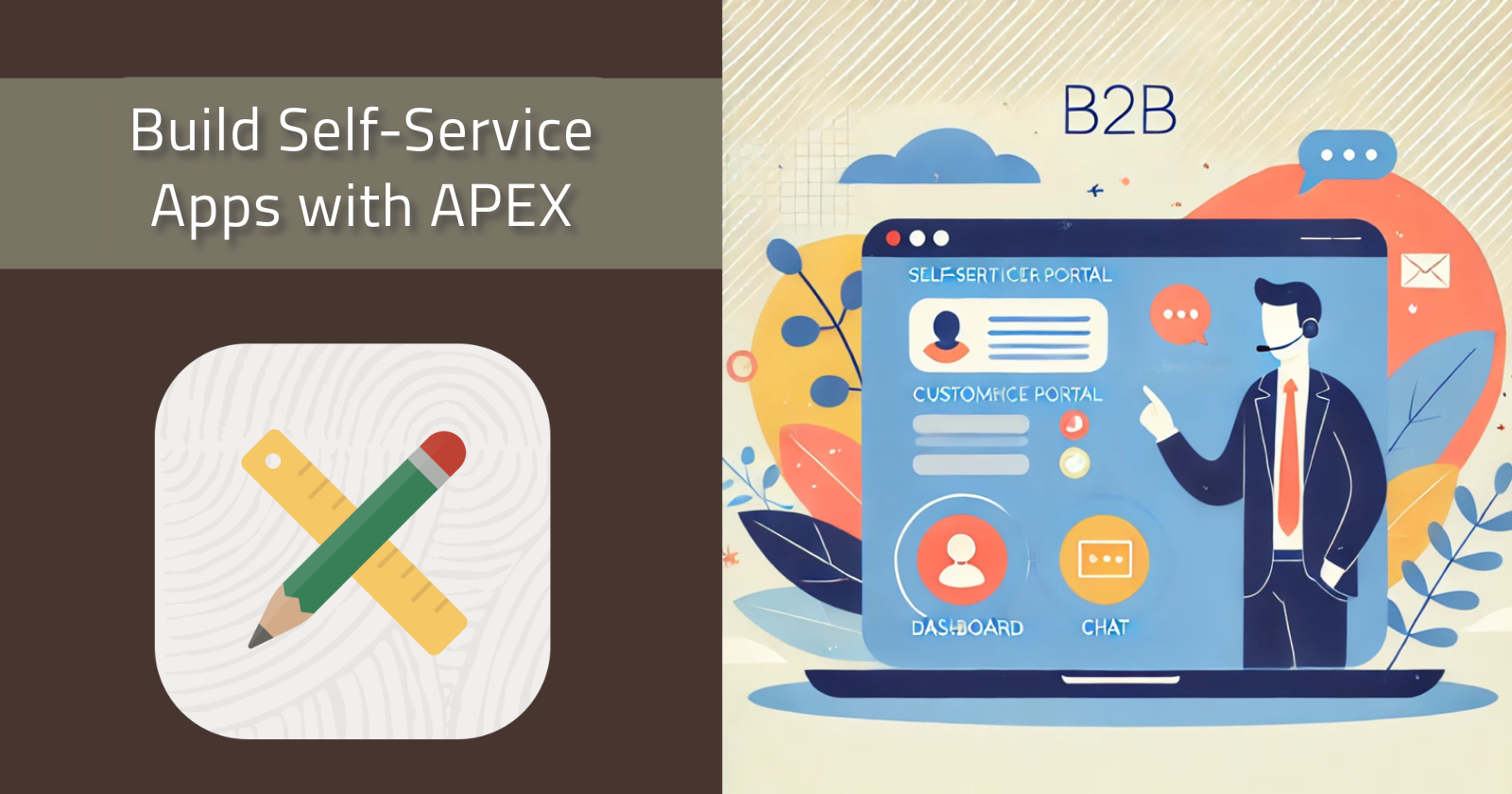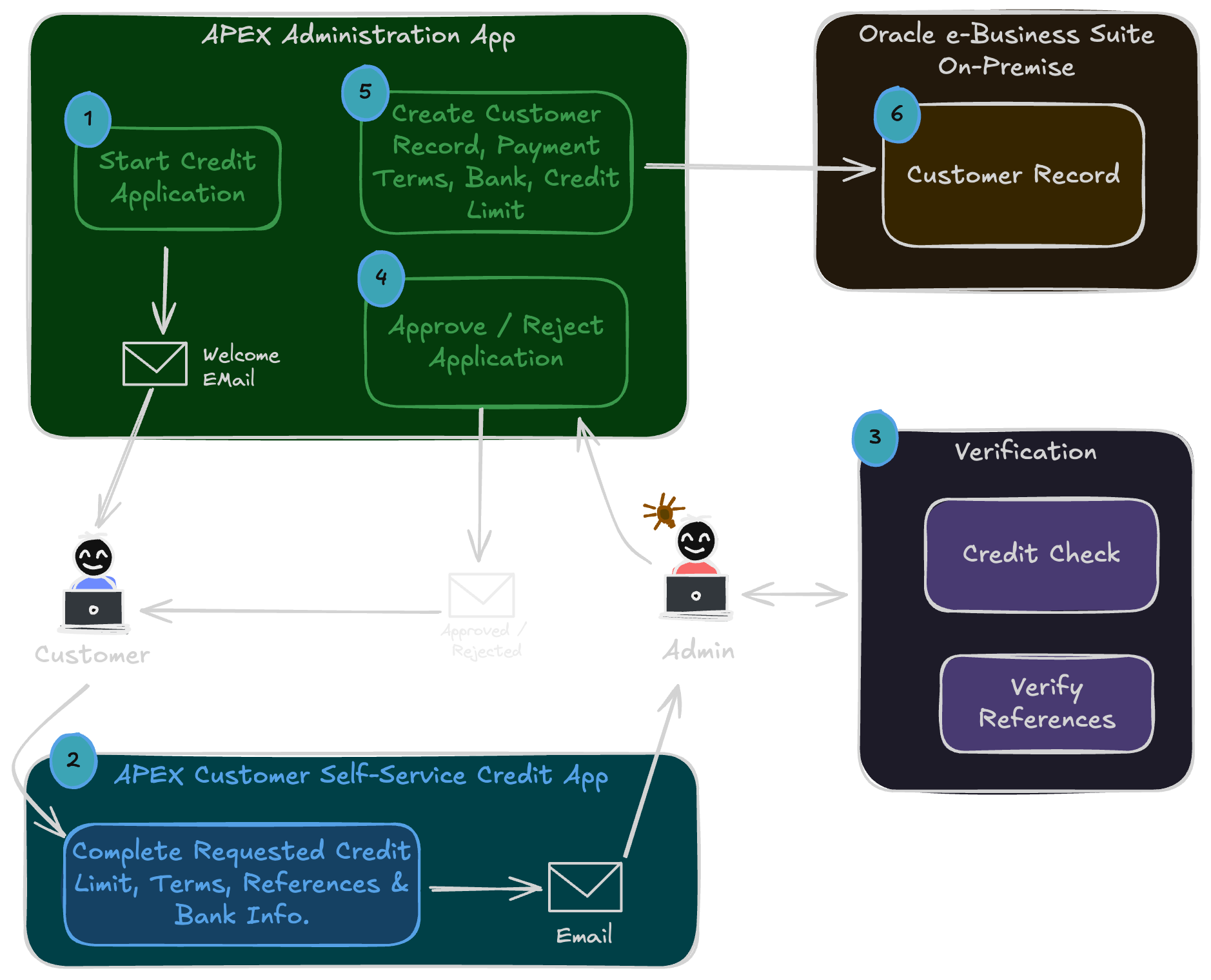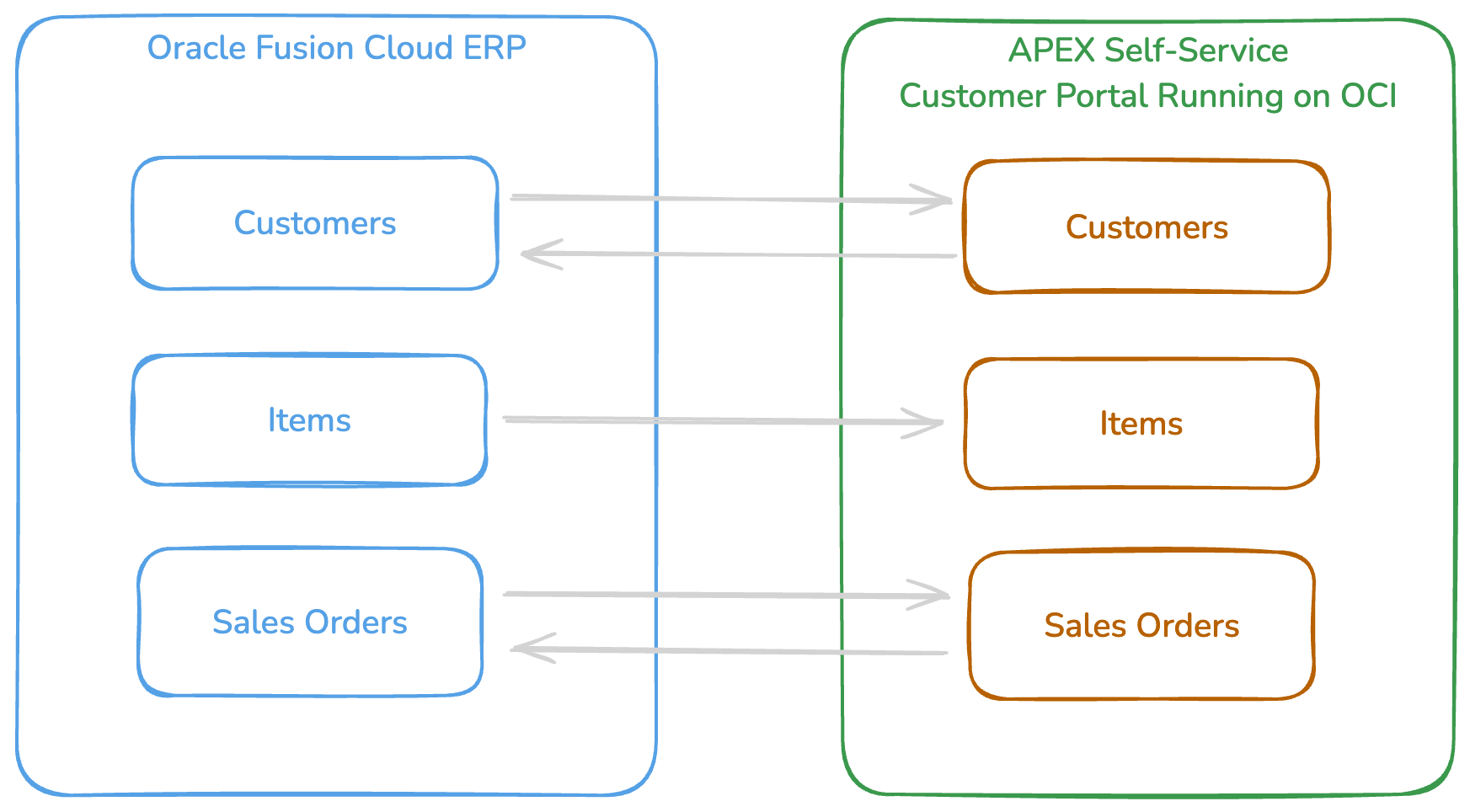Building B2B Self-Service Apps with APEX
 Jon Dixon
Jon Dixon
Introduction
If your organization relies on an ERP system like Oracle EBS or Oracle Fusion Cloud, maintaining high-quality master data can be a challenge. Outdated customer records can lead to inefficiencies and errors.
Do you want to engage more effectively with your customers, suppliers, and employees?
In this post, I will discuss the benefits of providing externally facing APEX Apps that allow the data owners to maintain their data and drive engagement simultaneously.
The Benefits
Allowing the actual entities (e.g., customers, suppliers) to verify and update their ERP data through a web app significantly improves data accuracy and timeliness, as it puts control in the hands of the people most familiar with that information. This self-service approach reduces administrative burdens, prevents data-entry errors, and fosters higher trust and engagement—customers appreciate being empowered to ensure their details (address, phone number, contact names, etc.) remain correct. Additionally, continuous verification leads to consistent, high-quality data across the enterprise, improving downstream processes such as billing, shipping, customer service, and analytics.
Two Use Cases
Credit Application

I recently built an APEX App for a customer, which allows them to manage the Credit Application process for their customers.
Internal Admin staff select a prospect, identify a primary contact, and send out a request to apply for credit email.
The email contains a link the customer clicks on to open the customer-facing Credit Application.
The App uses email authentication, which sends the customer an email with a one-time code, which they enter to authenticate.

- Once authenticated, the customer completes the Credit Application, including contacts, addresses, bank information, and references, and submits it for review.
Admin staff review and approve the Credit Application.
This triggers an email to the customer and creates a customer record in Oracle e-Business Suite if approved.
Benefits
The customer enters the data that they know best, which improves accuracy.
The customer is likely impressed that you have an App to manage Credit Applications instead of emailing Word documents.
It allows you to increase engagement with the customer.
An application like this, a Credit Application App, can quickly become a Customer Portal.
Much of the administrative burden has been passed on to the customer.
Customer Portal
A Customer Portal is another example of a self-service application that can bring significant benefits to your business, including increased loyalty, increased customer satisfaction, and reduced administrative burden for your team.
When companies offer customer portals with self‑service capabilities (for example, to track deliveries or manage service requests), they see measurable benefits
Features
Here is a list of features you should consider for a customer portal:
Provide product updates, available discounts, etc.
Provide a product catalog.
Manage contacts, addresses, payment methods, etc.
Provide the ability to enter Sales Orders directly in the portal.
Provide access to Sales Order Status, Delivery Dates, Tracking Numbers, etc.
Provide the ability to re-schedule deliveries.
Provide access to Invoices and Receipts.
Provide access to payment history.
24/7 availability.
Provide your customers with the ability to ask product questions.
Provide data-driven insights. For example, suggesting item A because the customer has previously purchased item B. This should be done subtly and provide insights that benefit the customer (as well as you) to avoid the customer feeling like he is shopping on Amazon.
Provide an FAQ page or AI features such as inquiring about product specifications if you are feeling adventurous.
Provide a platform for delivering customer satisfaction surveys.
Provides a foundation for building APIs. For example, customers can access their API keys from the portal.
Other Self-Service App Ideas
Here are some examples of other self-service Apps:
Supplier Portal
Problem/Issue Tracking
Employee Onboarding – New hires can complete paperwork and training online.
Leave & PTO Requests – Request time off and track remaining vacation days.
Performance Reviews & Feedback – Employees and managers can review performance reports.
Training & Certification Portals – Online learning and certification tracking.
Employee Self-Service Dashboards – Access and update personal information.
Why APEX?

Oracle APEX is a great platform for building self-service applications.
The APEX Service running on Oracle OCI is cost-effective, starting at around $150/month.
On Cloud Platforms like OCI ATP or APEX Service, APEX requires very little maintenance.
APEX is a powerful low-code solution that can grow with you as your business grows. You can start with a simple App built almost entirely declaratively and incorporate complexity only when needed.
Combining the Universal Theme, APEX Template Components, and the ability to add custom CSS allows for creating compelling user interfaces.
APEX provides many authentication options, ranging from simple email authentication to easy-to-implement SSO options from providers such as Okta, Google, MS ActiveDirectory, etc.
APEX provides out-of-the-box Workflow features.
Because APEX is built on the Oracle database, you can use Database security features like Data Redaction, Virtual Private Database, and Real Application Security.
APEX has proven integration capabilities with Oracle ERPs such as Oracle EBS and Oracle Fusion Cloud ERP. This lets you present a combination of locally synced and real-time data from your ERP in APEX and update your ERP data from APEX.
APEX comes with Oracle REST Data Services (ORDS). ORDS allows you to create secure REST APIs against the data in your database using SQL and PL/SQL. With ORDS built in, you can provide your customers with REST APIs so they can import data into their systems or change their data in your system via secure APIs.
APEX Apps can be installed and run on mobile devices using PWA functionality. This includes the ability to send push notifications, which may be helpful for delivery notifications.
Why not use your ERP’s Customer Portal?
There are several reasons why companies do not use the self-service apps built into their existing ERP software:
Limited Customization and Flexibility
- ERP self-service portals often have rigid structures that may not align with a company’s business processes. Customizing built-in self-service tools can be expensive and time-consuming.
Poor User Experience (UX) and Adoption Challenges
Many ERP self-service applications have complex or outdated interfaces, leading to a poor user experience.
Employees and customers may resist using them if they are not intuitive or require significant training.
Security and Compliance Concerns
Granting employees or customers direct access to ERP from outside your firewall may raise security concerns.
Industries with strict compliance regulations (e.g., healthcare, finance) may require additional security measures that the built-in tools do not support.
Lack of Advanced Features
- Many built-in self-service tools lack advanced capabilities like AI-driven insights, workflow automation, or robust analytics.
High Cost of Licensing and Implementation
Even if the self-service module is included in the ERP system, enabling and customizing it will require additional licensing fees.
Implementation and training costs can outweigh the benefits for some organizations.
Vendor Lock-in and Future Upgrades
Relying too much on ERP self-service functionality can create vendor dependency, limiting flexibility in future system upgrades or migrations.
ERP upgrades may introduce compatibility issues, requiring further investment in reconfigurations. Having said that, the same argument (to a lesser extent) could apply to any ERP integrations you build for your self-service App.
Integrations
You will need to build integrations between your APEX self-service App and other systems like HR, CRM, or ERP. Consider how you will build and maintain these integrations before building your self-service app. The good news is that APEX provides comprehensive integration capabilities that are out of the box.
The diagram below illustrates that for a customer portal, there are several entities you will need to integrate between Oracle Fusion Cloud ERP and your Oracle APEX Instance.

Considerations
Keep it simple, and don’t overburden your self-service apps with unnecessary functionality.
Provide personalized experiences wherever possible. For example, you can tell a specific customer that a particular item is on sale if you know they have purchased it before.
Don’t let your portal become stale. This means keeping the UI up-to-date and fresh and ensuring the features and data presented on your apps are current.
Where applicable, include video content. Host videos on a YouTube channel and use built-in APEX features to display, search, and play them.
Focus on security. APEX Applications are generally very secure out of the box, but security is particularly important given that self-service apps potentially expose ERP data.
Users are very familiar with search engines such as Google. Use APEX Application Search to provide Google-like search capabilities across multiple data sources, including local tables, REST APIs, and AI Vector/Semantic Search. This also helps in simplifying the UI.
What about AI?

It is hard to write a blog these days that doesn’t mention AI.
Please resist the temptation to add AI features to your self-service Apps unless they provide a real benefit to the user. One good use case is allowing customers to ask questions about your product specifications. APEX and Oracle 23ai make it relatively easy to implement a Retrieval-Augmented Generation (RAG) chat interface based on PDF technical specifications. The same goes for employee handbooks and other knowledge bases.
Conclusion
Implementing self-service APEX applications can significantly enhance data accuracy, reduce administrative burdens, and improve customer engagement by giving users direct control over their information. By starting small with essential features like record maintenance and order tracking, businesses can gradually expand functionality to create comprehensive portals that drive efficiency and satisfaction. Ultimately, leveraging APEX for self-service solutions provides a flexible, cost-effective alternative to traditional ERP portals, ensuring a superior user experience while maintaining integration with enterprise systems.
References
Here are some articles I used when researching this post:
Zendesk: Self-service: do customers want to help themselves?
This article references 14 statistics related to customer self-service apps.
Subscribe to my newsletter
Read articles from Jon Dixon directly inside your inbox. Subscribe to the newsletter, and don't miss out.
Written by

Jon Dixon
Jon Dixon
Hi, thanks for stopping by! I am focused on designing and building innovative solutions using the Oracle Database, Oracle APEX, and Oracle REST Data Services (ORDS). I hope you enjoy my blog.